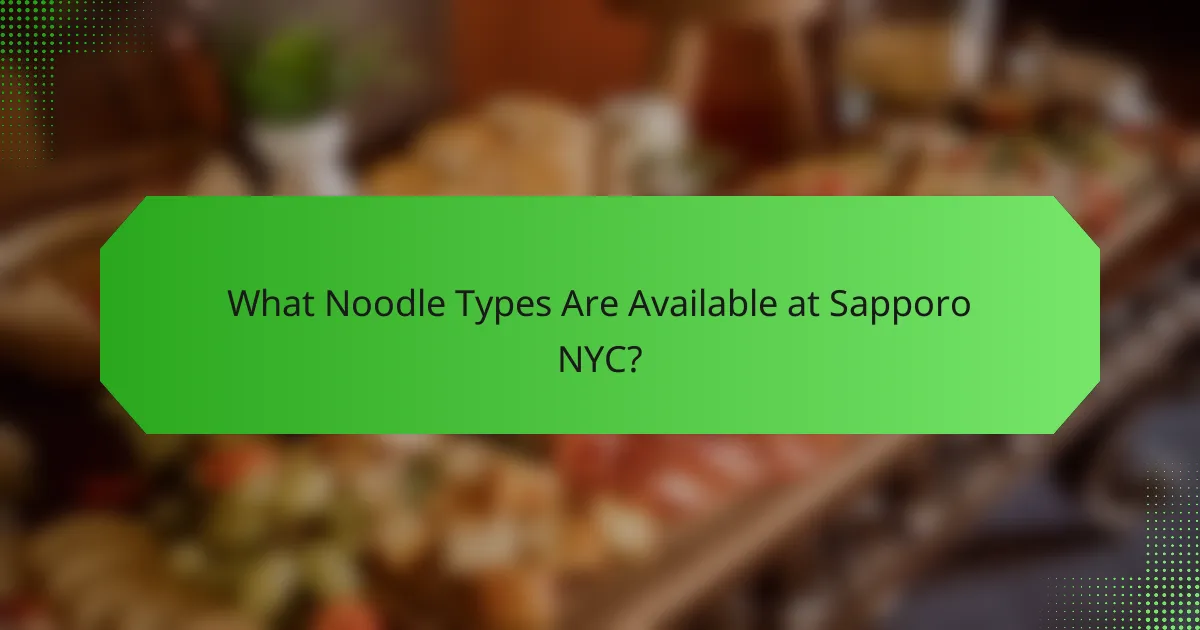
What Makes Sapporo NYC’s Ramen Stand Out?
Sapporo NYC’s ramen stands out due to its authentic Sapporo-style preparation. This includes a rich miso broth that is both hearty and flavorful. The noodles are thick and chewy, ideal for holding the broth. Sapporo NYC also offers unique toppings like sweet corn and butter, enhancing the dish’s richness. The restaurant sources high-quality ingredients, ensuring freshness and taste. Their commitment to traditional techniques further distinguishes their ramen from competitors. Each bowl reflects the essence of Hokkaido’s culinary heritage. These factors combined create a memorable dining experience for ramen enthusiasts.
How is the ramen experience at Sapporo NYC unique?
The ramen experience at Sapporo NYC is unique due to its authentic Sapporo-style preparation. This restaurant specializes in rich, flavorful miso broth, a hallmark of Sapporo ramen. The noodles are made fresh daily, providing a distinct texture and taste. Sapporo NYC also offers a variety of toppings, including corn, butter, and chashu pork, enhancing the overall flavor profile. The ambiance reflects a traditional Japanese izakaya, creating an immersive dining experience. Additionally, the restaurant’s commitment to using high-quality ingredients sets it apart from other ramen establishments. This combination of authenticity, quality, and atmosphere contributes to a unique ramen experience.
What are the key elements that define Sapporo NYC’s ramen?
Sapporo NYC’s ramen is characterized by its rich miso-based broth, thick curly noodles, and diverse toppings. The miso broth is hearty and flavorful, often enhanced with garlic and sesame oil. The thick curly noodles provide a unique texture, allowing them to hold the broth well. Common toppings include chashu pork, corn, butter, and scallions. These elements create a hearty and satisfying dish that reflects traditional Sapporo ramen styles. The restaurant emphasizes authenticity, using high-quality ingredients to ensure a genuine experience.
How does the ambiance contribute to the ramen experience?
The ambiance significantly enhances the ramen experience by creating an inviting atmosphere. A well-designed space can evoke the essence of Japanese culture. Elements such as lighting, decor, and seating arrangements contribute to the overall vibe. For example, warm lighting can make the space feel cozy and welcoming. Authentic Japanese decor can transport diners to Japan, enriching their meal. Additionally, the sounds of a bustling kitchen can stimulate appetite and excitement. Research shows that ambiance influences taste perception, making flavors seem more pronounced. Overall, a thoughtfully curated ambiance complements the flavors of the ramen and elevates the dining experience.
What are the different types of ramen offered at Sapporo NYC?
Sapporo NYC offers several types of ramen. The main varieties include Shoyu, Miso, and Tonkotsu ramen. Shoyu ramen features a soy sauce-based broth. Miso ramen uses a rich miso paste for flavor. Tonkotsu ramen is known for its creamy pork bone broth. Each type has distinct flavors and ingredients. The restaurant also serves variations with different noodle types and toppings. These options cater to diverse tastes and preferences.
What are the signature ramen dishes available?
The signature ramen dishes available at Sapporo NYC include Miso Ramen, Shoyu Ramen, and Tonkotsu Ramen. Miso Ramen features a rich, savory miso-based broth. Shoyu Ramen is characterized by its soy sauce-flavored broth. Tonkotsu Ramen is known for its creamy, pork bone broth. Each dish is served with fresh noodles and various toppings. These dishes reflect traditional Japanese ramen styles. They are crafted using authentic ingredients and techniques. Sapporo NYC is known for its commitment to quality and flavor.
How do the regional styles of ramen influence the menu?
Regional styles of ramen significantly influence restaurant menus by dictating broth types, noodle varieties, and toppings. Each region in Japan has its own signature ramen characteristics. For instance, Sapporo is known for its rich miso-based broth, while Tonkotsu ramen from Fukuoka features a creamy pork bone broth.
These regional differences lead to the inclusion of specific ingredients. Sapporo ramen often includes corn and butter, reflecting local tastes. Meanwhile, Tokyo-style ramen typically features a soy sauce-based broth with a lighter flavor profile.
Restaurants aim to offer authentic representations of these styles to attract customers. Consequently, menus are curated to highlight these regional distinctions, ensuring a diverse selection. This approach enhances the dining experience by providing a taste of various Japanese culinary traditions.

What Broth Varieties Can You Find at Sapporo NYC?
Sapporo NYC offers several broth varieties. These include shoyu (soy sauce), miso, and tonkotsu (pork bone). Each broth has a distinct flavor profile. Shoyu broth is savory and rich in umami. Miso broth is hearty and slightly sweet. Tonkotsu broth is creamy and full-bodied. These varieties cater to different taste preferences. Sapporo NYC is known for its authentic ramen experiences.
What are the main types of broth used in Sapporo NYC’s ramen?
Sapporo NYC’s ramen primarily features three types of broth: miso, shoyu, and tonkotsu. Miso broth is rich and savory, made from fermented soybean paste. Shoyu broth is soy sauce-based, providing a lighter and more aromatic flavor profile. Tonkotsu broth is creamy and hearty, made from simmered pork bones. Each broth type contributes unique flavors and textures to the ramen dishes. These broths are foundational to the restaurant’s offerings, catering to diverse taste preferences.
How does tonkotsu broth differ from shoyu broth?
Tonkotsu broth differs from shoyu broth primarily in its base ingredients and flavor profile. Tonkotsu broth is made from pork bones, which are simmered for long periods to extract collagen and fat. This results in a rich, creamy texture and a deep, savory flavor. In contrast, shoyu broth is soy sauce-based and typically uses chicken or vegetable stock as its foundation. Shoyu broth has a lighter, more delicate taste with a salty and slightly sweet profile. The preparation methods also differ, as tonkotsu requires extensive boiling, while shoyu is often quicker to prepare. Each broth type offers a unique ramen experience, catering to different flavor preferences.
What flavor profiles can you expect from each broth type?
Shoyu broth has a savory and slightly sweet flavor profile. It is made with soy sauce, providing a rich umami taste. Miso broth offers a robust and earthy flavor. The fermented soybeans in miso create a creamy texture and depth. Tonkotsu broth is known for its rich and creamy profile. It is made from pork bones, resulting in a hearty and fatty taste. Shio broth is lighter and saltier, often featuring a clear base. It highlights the natural flavors of the ingredients used. Each broth type provides a unique experience, enhancing the overall ramen dish.
Why is the broth important to the overall ramen experience?
The broth is essential to the overall ramen experience because it serves as the foundational flavor base. It defines the taste profile of the dish and influences the overall enjoyment. Different broth types, such as tonkotsu, shoyu, and miso, offer unique flavors and aromas. The richness and complexity of the broth can elevate the entire meal. A well-prepared broth enhances the harmony between the noodles and toppings. It also contributes to the mouthfeel and warmth of the dish. In traditional ramen, the broth is simmered for hours to develop depth. This meticulous preparation process underscores its importance in ramen culture.
How does the broth affect the taste and texture of the ramen?
The broth significantly influences the taste and texture of ramen. It serves as the primary flavor base, providing richness and depth. Different broth types, such as tonkotsu or shoyu, impart unique flavors. Tonkotsu broth offers a creamy, hearty texture due to its pork bone content. Shoyu broth, made with soy sauce, delivers a lighter, more savory profile. The broth’s temperature affects noodle texture, with hot broth softening noodles quickly. Additionally, the broth’s seasoning enhances overall taste, balancing saltiness and umami. A well-crafted broth elevates the entire ramen experience, making it essential for flavor and mouthfeel.
What role does the broth play in pairing with toppings?
The broth in ramen serves as the foundational flavor base that complements the toppings. It enhances the overall taste profile of the dish. The richness of the broth can balance or elevate the flavors of various toppings. For example, a rich tonkotsu broth pairs well with fatty toppings like chashu pork. Conversely, a lighter shoyu broth complements delicate toppings such as scallions or bamboo shoots. The temperature of the broth also plays a role. A hot broth keeps toppings like nori or soft-boiled eggs warm and enhances their flavors. Ultimately, the broth acts as a unifying element, harmonizing the diverse tastes and textures of the toppings.

What Noodle Types Are Available at Sapporo NYC?
Sapporo NYC offers several types of noodles for its ramen dishes. The primary noodle types include thin, curly noodles and thicker, straight noodles. Thin, curly noodles are ideal for lighter broths, allowing for a delicate balance of flavors. Thicker, straight noodles provide a hearty texture, complementing richer, more robust broths. These noodle variations enhance the overall ramen experience at Sapporo NYC.
What are the different noodle types used in Sapporo NYC’s ramen?
Sapporo NYC uses several types of noodles in their ramen. The most common noodle type is the curly, thick wheat noodle. These noodles are designed to hold broth well. Another type is the straight, thin noodle, which offers a different texture. Sapporo NYC also features a specialty noodle that is made fresh daily. Each noodle type complements specific broth varieties. The thickness and texture of the noodles enhance the overall ramen experience.
How do the thickness and texture of noodles impact the dish?
The thickness and texture of noodles significantly impact the overall dish. Thicker noodles provide a chewier texture, which enhances the mouthfeel of ramen. This texture allows for better absorption of the broth’s flavors. Conversely, thinner noodles create a lighter bite, often complementing delicate broths. The texture can also influence how the noodles hold up during cooking. For example, firmer noodles maintain their shape better in hot broth. Research shows that noodle thickness can alter the perception of flavor intensity in dishes. A study published in the Journal of Food Science indicates that thicker noodles can enhance the umami experience due to their surface area. Thus, noodle characteristics are crucial in determining the dish’s final taste and texture.
What are the traditional noodle styles used in Japanese ramen?
Traditional noodle styles used in Japanese ramen include straight, wavy, and thin noodles. Straight noodles are often used in shoyu ramen. Wavy noodles are commonly found in miso ramen. Thin noodles are typically served in tonkotsu ramen. Each style complements specific broth types. The texture and thickness of the noodles can affect the overall eating experience. Ramen noodles are usually made from wheat flour, water, salt, and kansui. Kansui is an alkaline mineral water that gives ramen its unique texture and chewiness.
How are the noodles prepared and cooked at Sapporo NYC?
The noodles at Sapporo NYC are made fresh daily. They are prepared using a specific blend of wheat flour. This process ensures a chewy texture that complements the broth. The noodles are cooked in boiling water until they reach the desired doneness. Cooking time is typically around three to four minutes. After cooking, the noodles are rinsed briefly to remove excess starch. This step enhances their texture and prevents clumping. Finally, the noodles are served immediately in the ramen bowl with the broth and toppings.
What cooking techniques are used to achieve the perfect noodle?
The cooking techniques used to achieve the perfect noodle include boiling, rinsing, and tossing. Boiling involves cooking the noodles in a pot of water at high temperature. This technique ensures the noodles reach the desired texture, typically al dente. Rinsing the noodles under cold water stops the cooking process. This step enhances the noodle’s firmness and removes excess starch. Tossing the noodles with oil or sauce adds flavor and prevents them from sticking together. These methods are essential for achieving the ideal noodle consistency in ramen dishes.
How does the preparation of noodles enhance the overall dish?
The preparation of noodles significantly enhances the overall dish by affecting texture and flavor absorption. Properly cooked noodles provide a chewy texture that contrasts with the broth and toppings. This texture is essential for a satisfying mouthfeel. Additionally, the cooking method influences how well noodles absorb flavors from the broth. For example, alkaline water used in ramen noodles enhances their elasticity and allows for better flavor integration. The ideal cooking time ensures noodles are not overcooked, maintaining their firmness. This balance between texture and flavor is crucial for a well-rounded ramen experience.

What Toppings Can You Add to Your Ramen at Sapporo NYC?
At Sapporo NYC, you can add various toppings to your ramen. Common toppings include chashu pork, soft-boiled eggs, and green onions. You can also choose from bamboo shoots, nori seaweed, and bean sprouts. Other options include corn, spicy miso paste, and garlic oil. Each topping enhances the flavor and texture of the ramen. Sapporo NYC offers a customizable experience for ramen enthusiasts.
What are the most popular toppings available for ramen?
The most popular toppings available for ramen include chashu, menma, green onions, nori, and soft-boiled eggs. Chashu is braised pork belly, known for its tender texture and rich flavor. Menma consists of fermented bamboo shoots, adding a crunchy texture. Green onions provide a fresh and mild onion flavor. Nori, or seaweed, enhances the umami taste of the broth. Soft-boiled eggs are often marinated, resulting in a creamy yolk that complements the dish. These toppings are commonly found in ramen shops and contribute to the overall flavor profile.
How do toppings complement the flavors of the broth?
Toppings enhance the flavors of the broth by adding texture and contrasting tastes. For example, green onions provide a fresh, sharp note that balances rich, savory broths. Chashu pork adds umami and richness, deepening the broth’s flavor profile. Nori introduces a hint of oceanic salinity, complementing the broth’s depth. Soft-boiled eggs contribute creaminess, enriching the overall mouthfeel. Each topping interacts with the broth, creating a harmonious blend of flavors. This synergy elevates the overall ramen experience.
What unique toppings does Sapporo NYC offer?
Sapporo NYC offers unique toppings such as spicy miso, corn, and butter. These toppings enhance the flavor profile of their ramen dishes. Spicy miso adds a distinct heat and richness. Corn provides a sweet contrast to the savory broth. Butter contributes a creamy texture that enriches the overall experience. Other unique options include chashu pork and soft-boiled eggs. Each topping is carefully selected to complement the ramen’s flavor. These unique toppings set Sapporo NYC apart from other ramen establishments.
Why are toppings essential to the ramen experience?
Toppings are essential to the ramen experience because they enhance flavor and texture. They provide a variety of tastes that complement the broth. Common toppings include chashu, green onions, and nori. Each topping adds a unique element to the dish. For example, chashu adds richness and depth. Green onions contribute freshness and crunch. Nori introduces a subtle umami flavor. Toppings also allow for personalization of the ramen bowl. This customization enhances the overall dining experience.
How do toppings contribute to the texture and presentation of the dish?
Toppings enhance both the texture and presentation of ramen dishes. They add layers of flavor and visual appeal. For example, sliced green onions provide a crisp texture. Soft-boiled eggs introduce creaminess to each bite. Nori sheets add a slight chewiness and a striking color contrast. Chashu pork contributes a tender, melt-in-your-mouth quality. Each topping serves a specific role in balancing flavors and textures. The combination of these elements creates a visually appealing dish. Studies show that presentation affects perceived taste and enjoyment. Therefore, toppings are essential for a well-rounded ramen experience.
What are some recommended topping combinations for the best experience?
For the best ramen experience, recommended topping combinations include chashu pork, soft-boiled egg, and green onions. This combination offers a rich flavor profile and satisfying textures. Another great option is spicy miso with ground pork, bean sprouts, and sesame seeds. This adds a kick and enhances the umami taste. Additionally, combining seaweed, corn, and butter creates a creamy and savory experience. These toppings complement various broth types and elevate the overall dish. Each combination has been praised for enhancing the ramen’s depth and complexity, making them popular choices among diners.
What Tips Should You Consider When Ordering Ramen at Sapporo NYC?
When ordering ramen at Sapporo NYC, consider the broth variety that suits your taste. Sapporo is known for its rich miso broth, which is a popular choice. Next, think about the noodle type; Sapporo typically offers thick, curly noodles that hold the broth well. Pay attention to the toppings; common options include corn, butter, and green onions. Customizing your order can enhance your experience; feel free to adjust spice levels or add extra toppings. Lastly, ask the staff for recommendations based on your preferences; they can provide insights into popular choices.
How can you customize your ramen for the best flavor experience?
To customize your ramen for the best flavor experience, choose a broth that complements your taste. Popular broth types include tonkotsu, shoyu, and miso. Each broth has a unique flavor profile. Next, select your noodle type; thicker noodles hold broth better while thinner noodles provide a different texture.
Add toppings to enhance flavor. Common toppings include soft-boiled eggs, green onions, and nori. Each topping adds distinct flavors and textures. Consider adding spices or oils, such as chili oil or sesame oil, for an extra kick.
Adjust the seasoning to your preference. Some may prefer a saltier broth, while others enjoy a milder taste. Experimenting with these elements allows for a personalized ramen experience. This customization approach has been embraced in ramen culture worldwide.
What should you know about portion sizes and sharing options?
Portion sizes at Sapporo NYC restaurant vary by dish. Ramen bowls typically serve one person. Sharing options are available for certain appetizers and side dishes. These can be ordered in smaller sizes for sharing. The restaurant offers a family-style option for larger groups. This allows for a communal dining experience. Guests can sample multiple flavors together. Understanding portion sizes enhances the dining experience. It helps in planning meals according to appetite and group size.
Sapporo NYC is a renowned restaurant specializing in authentic Sapporo-style ramen, characterized by rich miso broth, thick and chewy noodles, and unique toppings like sweet corn and butter. The article explores various broth varieties, including shoyu, miso, and tonkotsu, and discusses the impact of different noodle types on the overall dish. Key toppings and their contributions to flavor and texture are also examined, along with customization options for an enhanced dining experience. The ambiance of Sapporo NYC further enriches the ramen experience, making it a notable destination for ramen enthusiasts.


